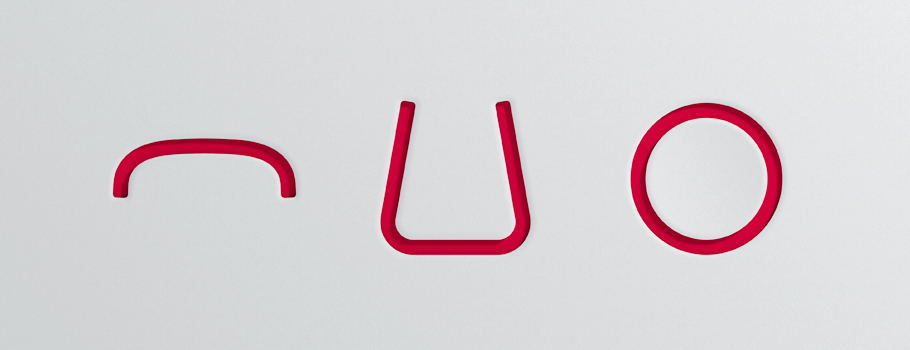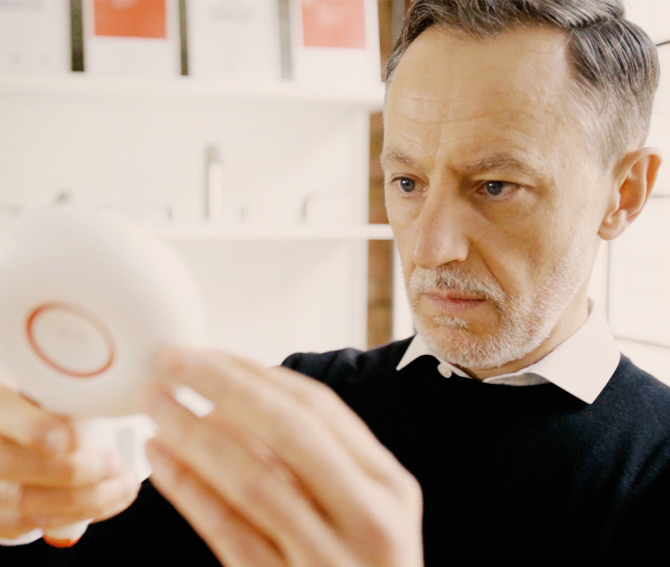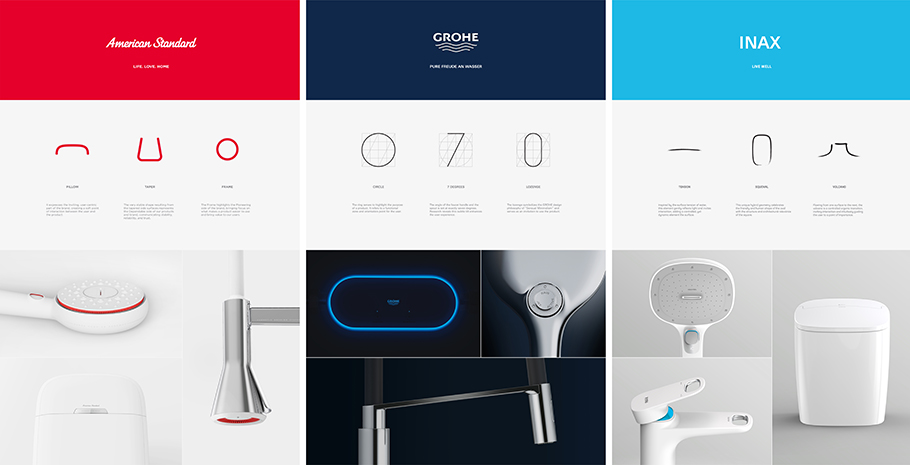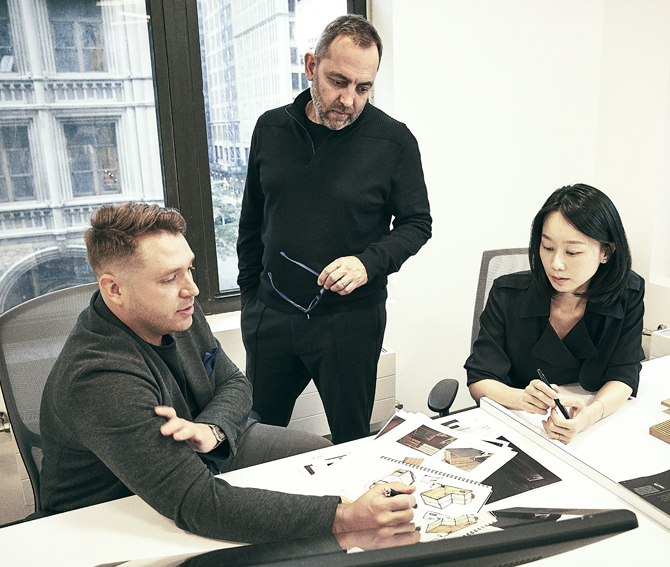LIXIL makes pioneering water and housing products that solve everyday, real-life challenges, making better homes a reality for everyone, everywhere.
- Global Site
-
- English
- Japanese
- Brand Sites
Global
- Global Site
-
- English
- Japanese
- Brand Sites

A defined curve. A strong taper. A vivid splash of red. These design elements are just the most visible signs of a deep transformation at American Standard, a world-renowned bathroom and kitchen brand whose name dates back almost a century and a half.
These features are part of a new range of design references called Signature Elements. Harnessing the power of design, they create distinctive products to meet evolving consumer needs. This reference line defines the look of American Standard products and makes them instantly recognizable. It’s integral to a strategy that has strengthened and unified a brand whose products, and even logos, once varied by region.
The changes at American Standard are another big step forward in LIXIL’s revamp of its major brands. This move began with GROHE in Europe and continued with INAX in Asia. The entire business was reimagined to put consumer-focused design at its heart and sharpen the regional and cultural character of each brand.
“The collection of brands allows LIXIL to operate in different markets in a truly authentic way, which a purely global brand simply can’t do,” says Paul Flowers, Leader of LIXIL Global Design and Brand Identity. “The transformation of American Standard is part of our strategy to realign our portfolio and allow the brands to play different roles in each market.”
Building the Brands

Flowers first made signature elements a foundation for visual brand identity while leading the design team at GROHE. Touches such as these had long been used in the automotive and electronics industries but were revolutionary for a maker of kitchen and bath fittings.
The approach worked. Flowers joined GROHE in 2005, and the innovative products his team designed soon helped push annual sales to new heights. In 2011, GROHE won the prestigious Red Dot industry award for design team of the year, recognized for the Signature Elements that were an essential part of non-verbal brand communication and helped create a distinct design identity.
Flowers joined LIXIL when it acquired GROHE in 2014 and applied his experience to refresh its other brands. Product development was refocused on what consumers want and on devising solutions relevant to the way they live.
“It’s really nice when you’re showing the world something new that is based on an approach that has already proven to be successful,” Flowers says of the changes at American Standard. “It reduces the risks of innovation and allows you to demonstrate its value for consumers and the business.”
Leading with Design
LIXIL’s design-led approach begins with what it calls “presearch”: studying consumer trends and behavior to ensure its products are meaningful and add value to people’s lives. This process goes back to the beginning. Instead of presenting people with a range of options to pick from, like much standard research, the designers at LIXIL observe people to understand their unmet needs. These insights are then fed into every aspect of design and product development.
The process also involves defining the values for each brand and translating them into the reference objects, so they are reflected in every product. The American Standard Brand is defined as inviting, dependable and pioneering. These values took shape as the signature elements – pillow, taper and frame.
“Our signature elements incorporate semantic elements that communicate directly with consumers,” Flowers says. “Our responses to the world are coded: rounded shapes are inviting; a strong base looks dependable. There’s a lot of psychology behind this that we can draw on. This allows consumers to identify our products at first glance.”

Elements and Reference Designs Click to enlarge
As well as forming the visual essence of the brand, these elements have practical applications. The curved pillow shape, for example, makes fittings easier to clean. A tapered bathtub that is wider at the top than the bottom helps save water. The red color, when used on a button, signals that a product is on.
At LIXIL, Design Starts with Presearch
When LIXIL’s designers are developing new products, their work starts outside the studio. They attend design events and tradeshows to understand current and upcoming trends, and the social drivers behind them. A lot of their time also is spent talking with consumers about kitchen and bath products and observing how they interact with them.
This process of gathering ethnographic and market insights is what LIXIL calls “presearch”, and it’s the foundation of the company’s consumer-focused strategy across its water brands – American Standard, GROHE and INAX. It allows designers to understand not just the preferences and pain points that people can explain, but also the responses they can’t put into words.
“The purpose of ethnographic research is to listen to our users and observe the coping mechanisms and unmet needs they may not even be aware of,” says Jean-Jacques L’Hénaff, Leader, LIXIL Global Design, Americas. “It allows us to understand what consumers want even when they can’t articulate it. And that helps us design the products that will appeal to them tomorrow.”
For L’Hénaff’s New York-based team – the design force behind the American Standard brand – COVID-19 restrictions made this vital process more difficult. Unable to carry out research in people’s kitchens last year, the team installed cameras that allowed them to observe remotely how people prepare meals. They came away with a better appreciation of the gap between what people say is important to them and what they can achieve with the technology at their disposal. These insights are now shaping the development of new water technology products.

When it comes to anticipating trends in design and technology, New York is the ideal place to be, L’Hénaff says. The city is America’s branding and communications capital as well as an architectural hot spot. Tapping into its dynamic energy and creativity helps the LIXIL team stay ahead, creating authentic American products that consumers across the country will embrace for years to come.
“The user-centric approach at American Standard is the key to our longevity,” L’Hénaff says. “It will always resonate – today and 10 years from now, just like it did a century ago.”
Bridging the Gaps
With multiple industry-leading water brands in global markets, LIXIL recognizes the importance of ensuring that each is culturally rooted in its home market and meets the needs of consumers in that region. For this reason, the presearch phase includes ethnographic research that contributes to a strong regional identity and makes each brand distinct from the others.
But being part of the wider LIXIL organization means synergies and efficiencies can be created between the distinct regional brands, too. This allows them to leverage technological platforms that are customized through brand and design lenses to make them relevant in each market. A good example is GROHE’s award-winning SmartControl line of shower systems and faucets – thoroughly European designs incorporating technology from INAX in Japan.
The goal of cultural relevance is facilitated by having eight major in-house design studios located in diverse urban centers, including London, New York, Tokyo, Düsseldorf, and Singapore. These cities are also architectural hubs, making it easier for LIXIL’s designers to stay on top of industry trends and stay in touch with clients.

Having an in-house design team is also critical to making LIXIL’s consumer-centric approach work. Its 120 designers work side by side every day with the company’s engineers and researchers, the marketing team, and even the factories that make its products.
“Because we’re so well plugged into the organization, we can call upon the expertise of thousands of people across the company,” Flowers says. “Our setup is quite unique in that sense.”
Relevant Innovation
The design team at the heart of LIXIL provides what Flowers calls an “objective barometer” that ensures the organization is focused on consumers and evolves along with them, staying relevant and adding value over the long term. The key is to marry design and brand to create immediately recognizable products that set LIXIL apart and inspire lasting consumer loyalty.
LIXIL’s designers are its insights people who can visualize an idea and make it tangible – and help the rest of the organization understand it. By always looking through the consumer’s eyes, the design team ensures that LIXIL never stops innovating. The American Standard reference line is the latest result of this approach.
“True innovation is when we surprise and delight consumers and we do it in a relevant way,” Flowers says. “More than one billion people use one of our products every single day. That’s a huge privilege and a huge responsibility. If each of our designs can make the world – and people’s daily routine – a little better, we can really make a significant impact.”
>> Follow LIXIL Global Design on Instagram
Our Stories
- Backing People and Passions to Drive Innovation
- How Toilets in Schools are Catalyzing Change in Communities
- Building the Future by Recycling the Past
- Reinventing Consumer Connections in the World's Largest E-commerce Market
- Tackling Household Water Inefficiency in a Water-Stressed World
- Plugging the Plumber Shortage
- Pioneering Solutions to a Sewage Crisis in Rural Alabama
- Meet the Citizen Developers Changing How We Work
- Design and Brand Identity Transformation at LIXIL
- Three Changes to Prepare Europe’s Sanitary Industry for Growth
- Three Steps to Creating an Inclusive Culture
- From Linear to Circular: Giving Products in Your Home a New Lease of Life
- Crafting Unique Experiences as well as Products
- GROHE X: A Digital Brand Experience
- Design-led Innovation Delivering True Value
- Responsible Use of Plastics
- Empowering our People for an Agile Future
- Turning the Waves of Change into Opportunities
- SATO Tap: a New Handwashing Solution for All
- New Ways of Working Take Flight at LIXIL
- INAX: Rituals of Water
- Refreshing our sanitation targets, standing firm on our commitments
- Developing Attractive and Differentiated Products
- Conserving Water: The New Normal
- Insulating For a Warmer and Healthier Home
- Open Kitchen, Open Communication
- Tackling Open Defecation in India
- Shaping the Future of Faucets, One 3D Layer at a Time
- Bathed in Culture and Tradition
- Remodeling the Housing Market
- LIXIL's AQUA CERAMIC makes bathroom stains a thing of the past
- The Technology of Water
- Tackling Challenges in Global Sanitation and Hygiene
